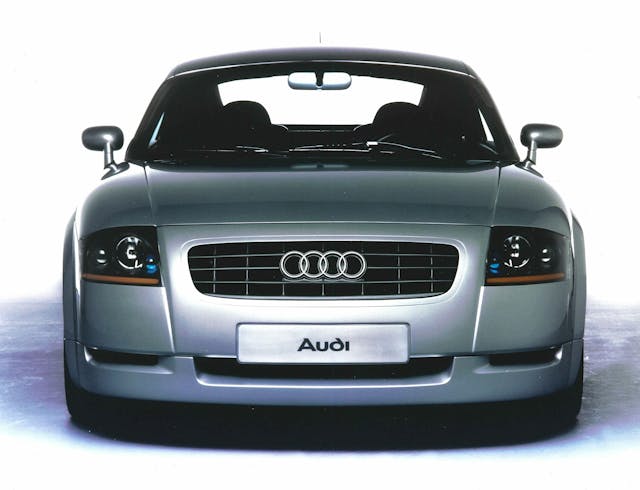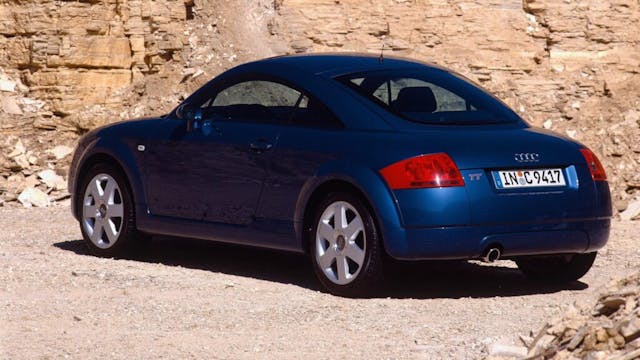This year marks the end of the road for a car that first landed as a monument of modern automotive design. The Audi TT hit the road in 1998 and experienced immediate success, elevating Audi’s street cred and helping evolve the brand from staid luxury saloon maker to, well, a luxury saloon maker with better taste. The TT’s fundamental appeal was its freshness. It leaned on neither retro cues nor nostalgia, instead adopting a simple, comprehensible aesthetic that was as exciting for the everyman as it was for design purists.
How did Audi arrive at such a formula? Not through endless focus groups and committee-led design sessions, but rather from a spur-of-the-moment idea. More specifically, Freeman Thomas’ idea.

Today, Thomas is CEO and Chief Creative Officer for Meyers Manx. Back in the ’90s, he was at Volkswagen and on the heels of a big success with the Concept One, a design project developed with J Mays that would ultimately become the New Beetle.
The original concept for the TT was born in March of 1994. “J had become the head of design for Audi,” Thomas tells Hagerty, “and he asked me to join him, and so I did an extended business trip.” A little while later, Thomas was doodling at his desk and created a thumbnail sketch, “which was basically a little identity of the TT.”


Mays saw it and asked if he could borrow the ‘little doodle.’ Thomas agreed and Mays walked it straight to to Franz-Josef Paefgen, Audi’s then-head of development, who fell in love with it. After that, it was just a matter of figuring out how to transform the doodle into a real-life driver’s car.
Mays, wanting to keep things quiet, arranged for a drawing table at Thomas’ apartment. It was up to the latter to refine the design in the evenings, while still doing his regular work in the studio during the day.
As the project progressed, Thomas eventually got a few more resources, including some modelers. He set himself to the task of creating a quarter-scale clay model, which Mays presented as a concept to Volkswagen Group execs, including the big boss Ferdinand Piëch, who Thomas says was “absolutely smitten.”
“And so that’s how it got cemented,” Thomas says.



The TT was first shown as a concept the following year, at the 1995 Frankfurt motor show. From there came the process of taking those initial sketches and making them into a production car, based on the Golf’s front-wheel-drive platform. That process, Thomas says, went seamlessly, which is not the case for every concept that ends up in showrooms.
“The design and the platform were really greatly suited for each other, and in no way, no how, did I ever feel that there was a compromise,” he says. In fact, one of the TT’s more notable styling cues – the way the hood blends into the fenders – was actually a product of the platform. Thomas initially planned to have a narrow hood, which wouldn’t fit, so he instead moved the shutline to the side, mid-way down the fenders. “An even better solution,” he says.

The car’s shape, which has remained basically unchanged for a quarter-century, was also a product of the tools available at the time. According to Hagerty design contributor Matteo Licata, a former automobile designer and current instructor at IAAD (Istituto d’Arte Applicata e Design) in Turin, “What you can see, toward the mid-’90s, is the very dramatic effect of surface 3D modeling software becoming really big.
“The designers playing with this new technology influenced their output, whether they liked it or not,” Licata says. “These more basic shapes, more basic volumes, intersected with each other.”


In fact, when Licata was himself learning 3D modeling software Autodesk Alias for his degree in design, his first assignment was to digitally re-create the Audi TT.
Sometimes limited tools and constraints create great things, and the resulting TT design was clearly a winner. “It is a perfect example of the zeitgeist of the era, of that precise moment in time in car design,” Licata says.

The TT resonated with the press from first blush. “My recollection is the media all loved it,” veteran automotive journalist Angus MacKenzie – the former editor-in-chief of MotorTrend, UK’s CAR, and Australia’s Wheels—told me. “It was seen as an instant design classic; a more original car than the BMW Z3 or the Mercedes-Benz SLK.”
Still, some automotive purists at the time panned the TT for its Golf-platform roots. That never bothered MacKenzie. “I remember the car feeling tight and fun. You could feel it was essentially a front-drive platform, as opposed to the Z3 and SLK, which had a traditional rear-drive sports car feel, but that didn’t diminish the enjoyment. Plus, it looked so cool on the road; there was nothing out there like it. You felt like you were driving a concept car.”
That otherworldly look helped drive its popularity elsewhere, too. “For a couple of years, the TT was the car to have,” Licata says. “Other coupes in the similar category, no one wanted them anymore. People had to have the TT, purely on the strength of the design that resonated with people … It became the car used on TV shows, in advertising, even for unrelated products.”
As good as it looked, though, it had one design flaw: imperfect aerodynamics. After a handful of high-speed accidents in Europe, early examples of the TT were recalled in 1999 to implement suspension and traction control improvements, as well as a new rear spoiler.
While many decried the little lip as ruining the car’s ideal form, Freeman Thomas is more pragmatic about it: “It wasn’t that unfortunate. I mean, it was so small.”
***
Audi left the TT largely unchanged through the 2006 model year, after which came the challenge of introducing a successor. “Once they captured lightning in the bottle,” Licata says, “the trouble is doing it again.”


“The second TT, in typical [head of VW Group Design Walter] de Silva fashion, was a very expertly made redesign. I love the sheer smoothness of it, the surfacing,” says Licata. “But it has nowhere near the staying power of the original, because it was a derivative design that also lost some pretty key elements.”
Some of those changes, Licata believes, were driven by cost: “They cheapened out the body stamping process of the rear end because it’s much smoother. The original TT had a very expensive rear quarter,” he says. But, ultimately, he’s a fan: “It looks great. Absolutely, well done. If I was tasked at the time to re-do a TT, I certainly couldn’t have done a better job than that.”
The third-generation TT, the final chapter for the 2015–2023 model years, lacks the self-assuredness and clarity of the preceding versions. The form is there, but there are a lot of tacked-on distractions. Audi designers were more true to the TT’s ethos on the Mk3 car’s interior, which forgoes a central display and makes a handsome motif out of the HVAC vents.


I asked Freeman Thomas about the legacy of the TT and its significance to the automotive community. For him, the genesis and path of the project itself was as significant as its product: allowing a designer and their team “to create something simple, pure … something that really communicates the brand values in an absolute sense. [The TT’s] legacy is its purity.”
Purity, Thomas argues, was a key ingredient in other design icons like the original Beetle, the Mustang, and the Miata. “Those are designer cars. Those are vehicles that are so easy to understand. They’re capable and functional, full of common sense, and the sad thing is that the companies only hold on to them for a certain period of time, and then they let it go. And what’s left are just normal vehicles.”
After 2023, Audi is letting the TT go, ostensibly for good. The car leaves behind a remarkable heritage for something with such simple underpinnings, which Thomas makes no bones about: “Basically, it was a Golf underneath. But then, a Porsche 356, in many ways, was basically a Beetle underneath.”










I ‘d see pictures of the concept TT, a few years before and couldn’t believe how similar the production car was when I saw pictures of it. I had to have one.
I bought my Black 225 manual TT in 1999 (second batch of 1000 into the UK). Nothing else like it. People just smiled and pointed at it all the time.. Surprisingly practical, especially the boot. Lovely styling, inside and out. I loved it.
Of course, it was recalled to Ingllstadt – for 6 months – during which time, I was loaned a new Audi A6.
I loved my TT and despite keeping it for 7 years, wish I’d never sold it. What a car.
A very interesting article. Back in 1998 when the first Audi TT hit the road, I was a Service Manager for a Rover Dealership – with over 30% of our work being warranty. In the same year we switched franchise from Rover to Volkswagen – right around the time of the ‘if only everything in life was as reliable as a Volkswagen’ adverts? Consequently, VW customer expectations were through the roof. So to say that was an interesting time is an understatement. Anyway, in 1999 I joined Volkswagen Group UK as an Area Aftersales Manager and stayed with the Group for a further 15 years in various field based roles. During that time I was lucky enough to have a couple of Audi TT’s as a company car. Of course, I went for the top spec V6 Quattro and whilst they were lovely cars to drive, very well built (I’d have to say that eh) with a host of high tech options, though I always felt that it needed a V8 to really cement it’s place in the market. Obviously, we didn’t get a V8, but we did get the TT RS which was quite something! I guess things have to move on, but it’s a shame to see the TT’s manufacturing life span come to an end. Although, there are many thousands still out there to satisfy the enthusiasts. Interestingly, I’ve just bought my wife a little 1998 MGF, so from the same era as the first TT, but light years apart in almost every respect.